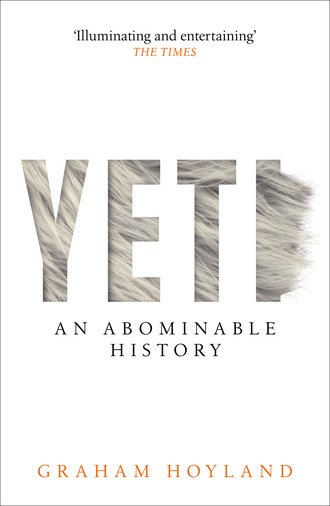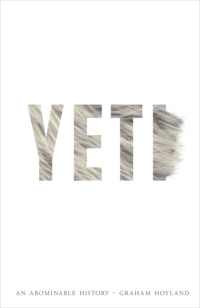
Полная версия
Yeti



Copyright
William Collins
An imprint of HarperCollinsPublishers
1 London Bridge Street
London SE1 9GF
WilliamCollinsBooks.com
First published in Great Britain by William Collins in 2018
This William Collins paperback edition published in 2019
Copyright © Graham Hoyland, 2018
Photographs © Individual copyright holders
Cover fur © Photoshop
Jacket design by Jack Smyth
Graham Hoyland asserts the moral right to be identified as the author of this work in accordance with the Copyright, Designs and Patents Act 1988
A catalogue record for this book is available from the British Library
All rights reserved under International and Pan-American Copyright Conventions. By payment of the required fees, you have been granted the non-exclusive, non-transferable right to access and read the text of this e-book on-screen. No part of this text may be reproduced, transmitted, down-loaded, decompiled, reverse engineered, or stored in or introduced into any information storage and retrieval system, in any form or by any means, whether electronic or mechanical, now known or hereinafter invented, without the express written permission of HarperCollins.
Source ISBN: 9780008279523
Ebook Edition © May 2018 ISBN: 9780008279516
Version: 2019-05-01
Praise for Yeti
‘Illuminating and entertaining’ The Times
‘A thorough and highly enjoyable round-up of current “cryptid credibility” written by someone with much Himalayan experience’ Literary Review
Praise for Graham Hoyland
‘A towering work full of twists and turns’ Independent
‘Great book, great vision’ Brian Blessed
‘This richly enjoyable book will entertain you on one page, enrage you on the next and make you get your walking boots on the third. I think it’s the most effective advertisement for the countryside I’ve ever encountered’ Daily Mail
A Times Book of the Week
Dedication
To the seekers after truth
Contents
Cover
Title Page
Copyright
Praise
Dedication
Introduction
Chapter One
Chapter Two
Chapter Three
Chapter Four
Chapter Five
Chapter Six
Chapter Seven
Chapter Eight
Chapter Nine
Chapter Ten
Chapter Eleven
Chapter Twelve
Footnotes
Bibliography
Index
Acknowledgements
Picture Credits
About the Author
Also by Graham Hoyland
About the Publisher
Introduction
October 2016
The footprints in the snow were large, bigger than a human’s, with clearly defined toes. There was no sign of claw-marks. These prints looked as though they had been made only minutes before we arrived. I shivered and glanced around the deserted valley. We were the first Westerners ever to see this place, and we really hadn’t meant to come here.
Our expedition was in trouble. We had been trying to reach Gangkar Punsum, the world’s highest unclimbed mountain. This lies on the Tibetan border in Bhutan, the Himalayan kingdom to the east of Kathmandu which is rarely visited by Westerners. The weather had been the worst in living memory, with rain or snow on every single day since leaving Thimpu, the capital. On day three, our packhorses were attacked by wild bees, and then our leader had suffered a back injury and was now lying in a crude shelter in the jungle four days behind, tended by our doctor. Our problem was that the high pass we had just crossed was now closed to our yaks by heavy snow. We couldn’t retreat that way, and the passes towards the mountain were closed too. We were trapped, and the 25 yaks only carried supplies for three weeks. We had to get out before winter set in. As the five remaining Westerners, we could have attempted to re-cross the pass, leaving the yaks behind, but as acting leader I was unhappy about splitting the party even further. We had to stay with our tents and food. We also had a whole yak-herder family with us, including a young mother nursing an 8-month-old baby, so it was clear that we had to sink or swim together.
I asked our yak-herder Namgay Tsering for advice, and it was then that he told me of a lost valley that might provide a route back to civilisation, with two higher but easier passes that the yaks could just about manage in the snowy conditions. So the next morning we set off, guided by Pem Dem, the 20-year-old mother, with her baby Thinley. The yaks were being gathered up and loaded and would follow up behind us. After a few hours, we walked up into the Lost Valley and Pem Dem sat down in the swirling snow to breastfeed her baby. It was only then that I noticed the solitary yak standing in the snow a few yards away. It seemed distressed. These animals are sometimes abandoned by the yak-herders when they are too old to carry heavy loads. This poor creature bellowed when it scented our baggage yaks coming up the valley behind. The significance of this animal was soon to be revealed.

Mother Pem Dem and son Thinley: the witnesses.
After feeding her baby, Pem Dem slung him onto her back again and we set off towards the Wangchum La pass at the head of the valley. We were all anxious about tackling this: at 16,400 feet it was the highest we had climbed so far, some 650 feet higher than Mont Blanc. It had never before been seen or crossed by Westerners. A few minutes later, just as the first bunch of baggage yaks stampeded past us, I spotted Sonam, our deaf-mute kitchen boy, pointing at the snow to the left of our path.
There they were: two footprints, spaced quite far apart, larger than human size. The left one was very clear, and my flesh crawled as I saw how the toes had curled into the snow for grip. The prints were larger than my own size-ten feet. My mind raced. I had to record this evidence and establish its authenticity in around twenty minutes. Any longer and I would be endangering our party. While I filmed the footprints and took a snow sample, Predrag Jovanovic, our resident particle physicist, scouted ahead and behind the prints, which crossed our path at right angles, away from the solitary yak. He reported that in one direction the baggage yaks had obliterated all traces, and in the other our own footprints had done the same.
Had we disturbed a stalking creature? Was some large predator lurking behind one of the huge boulders that were scattered around the Lost Valley? I stood up and uneasily gazed up at the large boulders on the snow-covered hillside above me. Was there something up there that I couldn’t see but the old yak could smell? I crouched down again and took scrapings of dirty snow within the footprints for DNA testing. I didn’t want to try to remove the whole footprint, as there was a chance that we might have to retreat from the pass. In that case we could camp, re-examine the print and scout around for further signs.
I knew that anyone hearing our story would assume these footprints had been faked, and this was foremost in my mind too, and so I hastened forwards to the rest of the party. Had they seen the prints? Had they seen anyone bending down? The answer was a flat no. Everyone was too intent on getting to the pass, and anyway I had everyone in view just in front of me. No one had even hesitated. We set off again. I was frustrated that I had no time to record the prints in more detail, but at least I was fairly sure that there was no fakery: Pem Dem was too busy with her baby and with route-finding, and I was watching everyone else closely for signs of fatigue. Sonam, although obviously an intelligent and helpful man, was impossible to question, being deaf and unable to speak.
In the event we crossed the Wangchum La, becoming the first Westerners to do so and leaving the Lost Valley behind us. We then camped below the Saga La, climbed it the next day and were eventually reunited with our leader who was now recovered. Later in the expedition, two of us stood on the summit of a previously unclimbed mountain and gazed over hundreds of square miles of country previously unseen by Western eyes. There was plenty of terrain here for the snow leopards whose tracks we saw regularly, so why not a larger predator? We saw blue sheep and musk deer, so there was surely enough prey.
So, what was the creature? Was it a bear? The absence of claw-marks suggested otherwise. Could it therefore be the mythical beast that is spoken of all along the Himalayas: the Abominable Snowman, or yeti? Is the yeti really living in the unexplored wilderness of North Bhutan?
I decided to find out what I could about the strange world of mythical beasts: the cryptids.

CHAPTER ONE

A surprising discovery … Attenborough, a believer … Tintin in Tibet … the Third Eye … upon that mountain … a hero of Mount Everest … a wild goose chase … a lost camera … his shroud the snow.
When I gazed at those yeti footprints in the Lost Valley, I felt a mixture of fear and bewilderment. It was only later that I felt a connection to those who had gone before. For nearly a century, Western explorers had been coming back from the heights with reports of man-like beasts in the Himalayas. They began with stories of strange footprints, then told of the violent deaths of their pack animals, killed with one savage blow. Their Sherpas told them that yetis were seven feet tall, covered with brownish hair. Their feet faced backwards, which made them confusing to track. The males had a long fringe of hair over their eyes and the females had pendulous breasts which they slung over their shoulders when they ran. Your only hope of escaping from a yeti was to quickly determine which sex it was and then run downhill if it was a male, who would be blinded by his fringe, or run uphill if it was a female, who would be impeded by her breasts. Sometimes lonely males would kidnap Sherpa women and keep them in their caves, breeding strange children.
I decided to look back through the years and try to disentangle myth from reality, cryptozoology from science. In thirty years of climbing in these mountains, why had I only seen footprints? Why had no one managed to capture one of these fabled beasts? Where did they live, and could I find any solid proof of the yeti? Furthermore, was there any evidence for Bigfoot, the yeti’s American cousin?
Mountaineering as a sport has collected a great literature around it in a way that, say, football or table tennis have not, so this book will take us through some of the most gripping accounts of the Abominable Snowman ever written. Cryptozoology itself has given us great fiction too, such as Arthur Conan Doyle’s The Lost World and Hollywood’s Jurassic Park. Somewhere in these pages lies the truth about these beasts and the dangers contained within them. This is a detective story, and like the best detective stories it starts with a discovery and a mystery.
We humans have only identified about two million of the estimated 10 million living species on our planet, and new species have been discovered in modern times that scientists had previously refused to accept. The gorilla was a legendary creature seen in the fifth century BCE by Hanno the Navigator, who described ‘a savage people, the greater part of whom were women, whose bodies were hairy, and who our interpreters called Gorillae. We pursued but could take none of the males; they all escaped to the top of precipices, which they mounted with ease, and threw down stones.’ The name was derived from Ancient Greek

Then there was the ‘African unicorn’, the okapi, which was only discovered in 1901. It turned out to be a relative of the giraffe. Even giraffes themselves were regarded as fabulous until the mid-nineteenth century. A hairy pig thought to be extinct since the Pleistocene, the Chacoan peccary, was found trotting around happily in Argentina as late as 1971. Live giant pandas weren’t seen in Europe until 1916, and the existence of the Komodo dragon was disbelieved until 1926. So there were plenty of precedents for legendary animals such as the yeti eventually being accepted by scientists once they had been found (and then shot) by Westerners.
Sir David Attenborough is convinced. ‘I believe the Abominable Snowman may be real,’ said the TV naturalist. ‘There are footprints that stretch for hundreds of miles and we know that in the 1930s a German fossil was found with these huge molars that were four or five times the size of human molars. They had to be the molars of a large ape, one that was huge, about 10 or 12 feet tall. It was immense. And it is not impossible that it might exist. If you have walked the Himalayas, there are these immense rhododendron forests that go on for hundreds of square miles which could hold the yeti. If there are some still alive and you walked near their habitat, you can bet that these creatures may be aware of you, but you wouldn’t be aware of them.’1
The New Scientist magazine, reporting on a photograph of a yeti footprint, was confident that the creature existed. Like Attenborough, the writer concluded that it could be a giant ape: ‘The Abominable Snowman might well be a huge, heavily-built bipedal primate similar to the fossil Gigantopithecus … the Snowman must be taken seriously.’2
And what about the North American cousin of the yeti, the Bigfoot? ‘I’m sure that they exist,’ said the celebrated primatologist Jane Goodall on NPR radio. ‘I’ve talked to so many Native Americans, who’ve all described the same sounds, two who’ve seen them.’3
There was good reason to believe, therefore, that I had been close to a large primate unknown to science. Had I disturbed the beginning of a stalking manoeuvre which would have led to the violent death of the solitary yak? The predator would have to have been big enough to take on a yak bull, with jaws and teeth powerful enough to kill it. Or would it despatch the animal with one savage blow, and then turn towards me?

When I was a child, all I knew about the Abominable Snowman was what I had read in Tintin in Tibet, drawn by the Belgian cartoonist Hergé and published in 1959. Tintin has a dream in which he sees his Chinese friend Chang lying in plane wreckage. Tintin, Captain Haddock and Snowy the dog travel to Kathmandu, then trek to Tibet. After various adventures they encounter the terrifying yeti, or migou, and their porters run away. Eventually Chang is found in the yeti’s cave, having been nursed back to health by the beast. They all return to civilisation without a proper encounter with the animal, who watches them depart with apparent sadness. In the last frame, Chang says: ‘You know, I hope they never succeed in finding him. They’d treat him like some wild animal. I tell you, Tintin, from the way he took care of me, I couldn’t help wondering if deep down, he hadn’t a human soul.’
The drawings in the book were inspired by reports from the Golden Age of Himalayan climbing, then in full swing. Kathmandu is represented as it was in the 1950s, with no cars or even bicycles, just porters, and the city’s streets are so empty they are covered with red pimento peppers drying in the sun. I was entranced by the drawings of the mountains and in particular by the idea of a giant man-beast with a coconut-shaped head. How wonderful it would be if there existed a huge, orange, hairy creature, living in the high mountains, unknown to science! How marvellous it would be to contact him, to learn his language and protect him and his furry family! No doubt he would look just like the yeti in Tintin in Tibet, and would be a giant, cuddly, missing link.

Tintin Yeti
However, as with most children’s books there was a darker adult subtext. During composition, Hergé (Georges Remi) was in the throes of a mental breakdown caused by the realisation that he had fallen out of love with his wife Germaine, whom he had married in 1932, and fallen into love with Fanny Vlamink, a colourist who worked with him at the Studios Hergé. Fanny was 28 years his junior and a master of the colouring technique that he felt he had never quite come to grips with. Hergé’s breakdown included nightmares about the colour white:
At the time, I was going through a time of real crisis and my dreams were nearly always white dreams. And they were extremely distressing … At a particular moment, in an immaculately white alcove, a white skeleton appeared that tried to catch me. And then instantly everything around me became white.4
Hergé, a Catholic, went to see a Jungian psychoanalyst who interpreted his dreams as a search for purity and tried to persuade him to abandon his work. He ignored the advice and persisted with Tintin in Tibet, which eventually became his favourite work. The book’s plates contain large areas of the colour white depicting the snowy Himalayas (Tibet, of course, is largely an orangey-brown high-altitude desert). The mountain above the Tibetan monastery is called the White Goddess. And Tintin’s companion is a white dog named Snowy. Hergé himself stated that the story ‘must be a solo voyage of redemption’ from the ‘whiteness of guilt’.5
Of course, these interpretations can be taken too far: Tintin’s other companion is the alcoholic sea-captain Archibald Haddock. His name came from ‘a sad English fish’ cooked by the long-suffering Germaine.
It is worth noting that the front cover of Tintin in Tibet does not incorporate an image of the yeti, just his footprints. In the picture, Tharkey, the loyal Sherpa (another Western archetype), looks matter-of-fact, as if to him the yeti is an accepted phenomenon, but Tintin and Captain Haddock look astounded by the size of the footprints in the snow.

Tintin in Tibet
As a child during the 1960s, I became interested in Tibet and Buddhism. One book that went around my school in Rutland was The Third Eye, an autobiography by the Tibetan lama Lobsang Rampa. It is a gripping read. Born to a wealthy Lhasa aristocrat, he has a hole bored in his skull to reveal a third eye with which he discerns the auras of those around the Dalai Lama, and thus understands their true motives. He sees the British ambassador Sir Charles Alfred Bell as naive but unthreatening, but warns the Dalai Lama that the Chinese diplomats are a real threat to Tibet’s independence and that he must prepare for war and invasion. He practises levitation and clairvoyance.
Tuesday Lobsang Rampa (to give him his full name) also describes an encounter with a yeti. ‘We looked at each other, both of us frozen with fright for a period which seemed ageless. It was pointing a hand at me and making a curious mewing noise like a kitten. The head had no frontal lobes but seemed to slope back almost directly from the heavy brows. The chin receded greatly and the teeth were large and prominent. As I looked and perhaps jumped with fright, the yeti screeched, turned and leaped away.’6
The Third Eye was immensely popular and became a bestseller. There were follow-ups: Doctor from Lhasa and The Rampa Story. I, for one, was absolutely gripped and couldn’t wait to get my hands on the next T. Lobsang Rampa book. After all, boys reading this stuff were considered cool.

Unfortunately for us, T. Lobsang Rampa was in fact Cyril Hoskins, a plumber’s son from Plympton, Devon. Cyril didn’t possess a passport, hadn’t ever been to Tibet and couldn’t even read or speak the language. The whole series of books had been faked.
Hoskins had been uncovered by the real Tibetologist and climber, the great Heinrich Harrer, who had become suspicious of one of the books. Before the Second World War, Harrer had been attempting to climb the mountain Nanga Parbat in British India when he was captured and interned in a prisoner of war camp. Being Harrer, he managed to escape, cross the border into Tibet and become the young Dalai Lama’s personal tutor. He was the real thing: a mountaineering hero. On reading The Third Eye, he became suspicious of certain details. There was the description of a tropical oasis on the Tibetan plateau, something which does not and cannot exist. The plateau itself was described as being at an altitude of 24,000 feet instead of around 14,000 feet. There were other discrepancies, such as Lobsang Rampa’s claim that the Tibetan apprentices had to memorise every page of the Kangyur Buddhist Sutras. These were not even read by students.
Harrer and other Tibetan scholars became convinced that the book was fiction, so they hired Clifford Burgess, a private detective from Liverpool, to investigate Lobsang Rampa. He revealed Cyril Hoskins, and the whole inglorious story of fakery was exposed on 3 February 1958 in the Daily Express under the headline: ‘The Full Truth About The Bogus Lama.’ It turned out that Hoskins had got the idea for The Third Eye by reading books such as Harrer’s Seven Years in Tibet in the London libraries.7 T. Lobsang Rampa lived to write again, however, producing books such as Living with the Lama and My Visit to Venus.
The significance of this tale is not the fact of the hoax but the amount of credence attached to it. I swallowed the story whole. So did my school friends and most adult readers. The Third Eye inspired many who later became Tibetologists, and in many ways T. Lobsang Rampa helped to start New Age culture. We wanted to believe in him. And we wanted to believe in his yeti.






